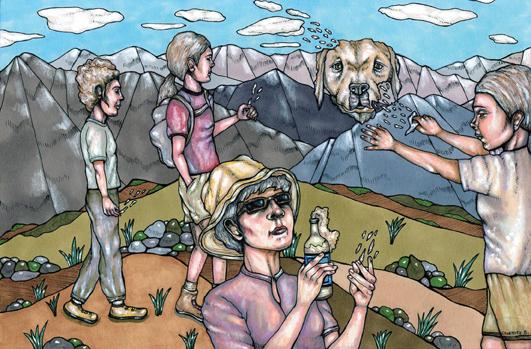The Core Four
It was enough that we pledged to show her dead body to her yellow lab, Shamus. Now we were asked to spread her ashes atop “Lady B.” It’s what lifelong friends must do.
Dee Ann outlived Shamus, and she will most likely outlive us all. She’s a member of the Core Four: a group of feisty women who, in their glory days, played hard outside Bozeman. They are Jennifer, Dee Ann, Cathy, and me. We bagged 10,000-foot peaks as an afterthought, skied in and out of bounds, canoed the great rivers, and helped each other through life’s peaks and valleys. Lady B, by the way, is Mount Blackmore.
Anyway, the Core Four has long since scattered to different zip codes. I received my ashes-spreading-request by letter, addressed to me in Sacramento, California. Here, the elevation is 52 feet, some 10,000 feet below the summit of Mount Blackmore. I’ve traded my hiking poles for chopsticks, and my Gatorade for chardonnay.
Dee Ann moved to Livingston and I’m pretty certain that she can see Lady B no better than me. Truth be told, she used to think that Blackmore, the prominent pyramid-shaped peak that defines the southern Bozeman skyline, was Hyalite Peak. This came out one day when we drove east on Highway 90 from Three Forks, after some epic hike in the Tobacco Root Mountains. She pointed to what I knew as Blackmore, saying, “I know I’m home when I see Hyalite Peak.”
“What do you mean?” I questioned, growing up with this landmark as my compass. “That’s Blackmore.” Though she'd lived in Montana long enough to consider it home, I am Montana born. I played the native trump card and noted that my father was Ranger Ross, Public Information Officer for the Gallatin National Forest. In fact, he placed the register at the top of the magnificent mountain. Blackmore is one of his favorite peaks; surely he would know and could settle our dispute.
We drove in silence to find my father, each anxious about the possibility of being wrong. Dad got out his maps and pointed, and while I was sorry for her, I don’t deny feeling relieved. It was, is and shall forever be, Mount Blackmore. My world was confirmed; hers would require a paradigm shift, perhaps like learning there is no Santa Claus. She was a far better sport than I would have been.
Lady B became a symbol of our friendship, the ability to not only reconcile differences in perspective, but to honor them. As such, we climbed Mount Blackmore annually and talked about her as if she was a third girlfriend. “Lady B” this and “Lady B” that. We even took regular walks to the grave of her namesake, Mary Blackmore, also a pyramid-shaped monument, set in Sunset Hills Cemetery.
Lord and Lady Blackmore, like many of us, left their homeland (England) to visit the West. Except in those days, death was more likely on such travels. She and her husband agreed that if either should die, they would simply be laid to rest where they perished. Unfortunately, Mary Blackmore fell ill in Bozeman and died. Her husband, William Blackmore, bought five acres on which to bury his wife and donated the land to the town for use as a cemetery, now known as Sunset Hills. Gravestones or monuments hold the space, marking the presence of loved ones. They symbolize the fragility of life.
In our case, Lady B’s monument serves as a meeting place, for the “same time next year.” Looking south from the grave, one can see Mount Blackmore, and this year the Core Four are scheduled to hike the 5.6-miler that climbs more than 3,000 feet through mountain meadows, past a quiet lake, and to a summit with far-away views over the Gallatin Range.
If Dee Ann’s day comes before ours, we are to spread her ashes “like falcons on the wind,” drink champagne, and make a toast to life. All well and good, we say. Agreed, we shall carry out the task as friends-for-life do. But in the meantime, let’s just sit and honor the view, grateful to be playing outside Bozeman again, forever friends atop Lady B.






